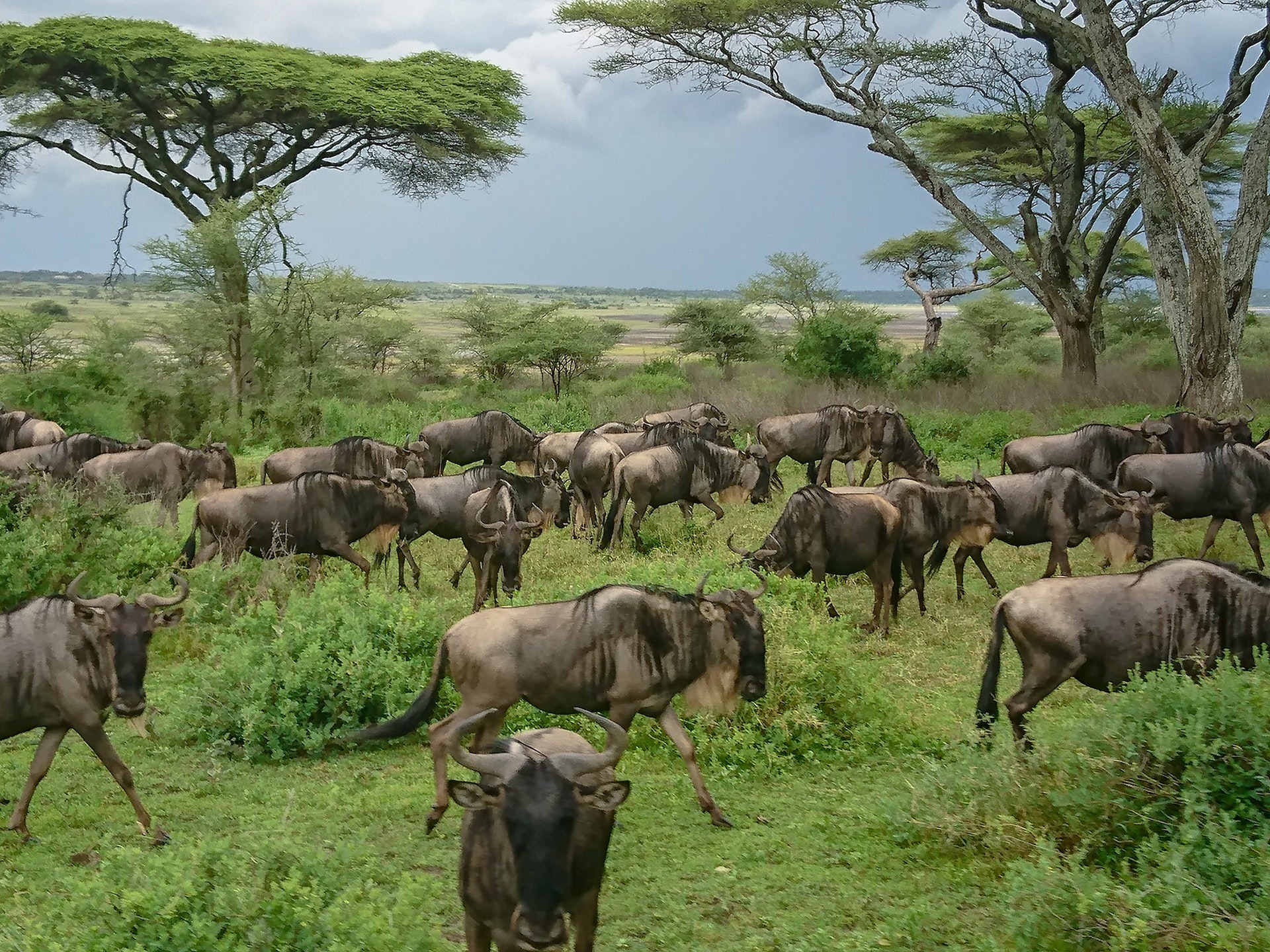When you hear the word Serengeti National Park, Endless plains, overwhelming wildlife, and breathtaking sunsets are what come to mind for more travelers. Welcome to Serengeti National Park. Here you can see over a million wildebeest and zebras crowd together, hooves kick dust and lions hunt at dawn.
If you want to witness the world’s largest overland migration and the Big Five, this is the place to be. Enjoy one of the most breathtaking natural wonders in Africa.
Best Things to do and see in Serengeti National Park
Now, this is what sets Serengeti apart from the rest.
Serengeti has uncountable activities and all of them are unique in their own style. This has made Serengeti a park to visit the whole year round since there is time you’ll go there and feel disappointed. Let me highlight you the most epic things to do and see in Serengeti national park below;
- Birding to up to 500 species of birds
- Hot air balloon
- Game viewing
- Great wildebeest migration
- Calving experience
- Live predation
- Maasai rock paintings
- Walking safari.
Great Wildlife Migration
Every year, more than 1 million wildebeests migrate from Serengeti National Park to Maasai Mara Game Reserve. In this natural and truly a wonder of the natural world, wildebeests are accompanied by thousands of zebras and other ungulates chasing the greener pastures.
To help you understand the Great Wildebeest Migration, let’s go through the following frequently asked questions about this unique and fascinating phenomenon.
Animals are included in the wildlife migration
- Wildebeests
- Zebra
- Grants gazelles
- Thomson Gazelles
- Impala
Parks covered by Migration
Ngorongoro National Park – In the early stages of Migration when the herds are in Calving, they usually cape alongside Ndutu area which is Northern Ngorongoro but in the Southern parts of Serengeti.
Once the calving season is over and the calves have already fed on the nutrients of the Ndutu area grass, a move to Central Serengeti is imminent.
Serengeti National Park – The most part of Migration is in Serengeti, both Central and North
Masai Mara Game reserve – after crossing the Mara River around August all the way to late October (sometimes the crossing goes all the way to early November) they’ll stay in Masai Mara Game reserve to before coming back to Serengeti as they’re needed in South Serengeti for Calving in February.
Best time to Visit Serengeti – when Can I see the migration?
Generally, you can see the Great migration almost the whole year. In fact, these wild animals use the circular movement in migrating around Serengeti for the full year so it will only depend on what event you’d like to experience in the migration.
Note: In this best time to visit the Serengeti guide, we’ll put much of our emphasis on the herds tracking. They are the main attraction in the park and once you see them, be sure that the big cats are around the looking to serve themselves with a kill or two.
A month by month guide to the migration
To get a better idea of the migration, let’s see a month by month guide which shows exactly where to find wildebeests at what months.
From December to March – After coming back from Masai Mara, it is within this period when calving starts. During these moments, wildebeests and their colleagues are found in the Southern Serengeti on the upper parts of the Ngorongoro Conservation Area, the place they consider the best for calving season.
In the Southern Serengeti, there are shorter grasses which makes it an ideal place to give birth as the openness of the plains makes it easier for the herds to see the predators.
Another reason that the herds prefer Southern Serengeti is due to the truth that the land is so fertile (following the remains of the volcanic ashes after the eruptions that later sunk to form Ngorongoro crater) with the grasses full of nutrients for the new babies.
The herds won’t leave this area before the calves have got enough nutrients from eating fresh Southern Serengeti grass which has a reputation of giving the young calves the stamina they need for the coming journey towards central Serengeti.
April and May
This is the period when some of the wildebeests and their colleagues start to move from Southern Serengeti towards other parts of Serengeti.
Nevertheless, South Serengeti along the Ndutu area is still the best place to be during this month where the herds can be witnessed in a bit dispersed way.
Since Ndutu has resident cats, in the April cats viewing becomes another excellent experience in the Southern Serengeti. Along with the previous months of March and February, this zone of Serengeti National Park offers an amazing live predatory action.
From May, most of the herds will go on and continue their mission to reach North Serengeti, however, this is the best time to experience the migration at the central Serengeti.
As the other herds move all the way to the Western corridor around the Grumeti area, again in May, just like in the previous month usually experiences heavy rains around all parts of Serengeti, this forces herds to disperse so during this time you’re not likely to see herds in large concentration.
Nevertheless, wildlife viewing is fantastic during these two months around the Seronera area, the central Serengeti.
June and July
As you can tell, the gestation period for the wildebeests is roughly 9 months. For them to give birth in February, this is their time for mating and you can find this happening at a very large number.
As the rainfalls start to cool, these two months are the best to experience the herds spreading across all the Central Serengeti and Serengeti Western corridor.
Cat life is also at its best here as the Seronera River usually attracts enough prey which is always a good thing to the cats.
Again, during June and July, as some of the herds tend to head to the Western Serengeti, you may be rewarded by the small crossings of the Grumeti River as the herds leave the park to enter the Singita Game reserve.
In July, there is no better place to be than the Kogatende area. While it’s fair to say that during this period herds can be seen anywhere around Central, West, and Eastern Serengeti.
August, September to October
While Migration can be experienced the whole year round, this is arguably the best time.
With fewer rains, these months are when the herds cross the Mara River almost daily and in a very huge spectacular group.
Kogatende area is again the best place to be during these months as it gives you the best opportunity to see the herds crossing in crocodiles infested Mara River while the big cats monitoring the situation closely in sidelines, waiting for a proper prey.
While there have been a lot of theories about the river crossings, but the truth is this is not something that can be explained logically. Wildebeests and co know naturally what to do and at what time.
If they sense that the rainfall is about to start on the next side of the river, they are likely to cross. A few days later or even just a matter of hours after crossing the river, these herds may decide to cross back depending on how they read the weather.
Furthermore, it isn’t necessarily that the herds will head to the North after they have stayed in the central and western corridor of Serengeti. Some of the herds may well decide to go back to the South or head all the way to the north and cross the river. The main determinant here is the direction of the rainfall.
From November
As the rains start in Southern Serengeti in the plains of Ndutu area where the herds were lastly seen at the start of the year, you can tell the way the fresh grasses are longing to be consumed by the newly born babies as early as February.
With also the rains heading to the South, this is the time when the herds start to herd south as they are needed to be at the right place for the calving, come early February.
During November, you may still be lucky to see some crossings, depending on the year.
In 2019 for example, the magnificent crossings were somehow experienced all the way up until the mid of November.
As I have mentioned, again and again, there is no rule of thumb for the wildebeest’s migration, what we know at the moment is that the rains are the main determinant. There might be the other reasons that the wildebeests know themselves but really, this natural event is worth tracking and I would advise if you need to explore it at its fullness, find a way to visit when you have a no a very pressing timetable.
How Much does a Serengeti Safari cost?
Now you know almost everything about the best safari park of the continent, you might be wondering, how does it cost to visit Serengeti?
Well, the answer is, there is no fixed price.
Travelers may pay different costs to visit Serengeti depending on the following;
- The number of days in a Serengeti safari.
- Number of people in your group, the more people in a group will reduce cost per person through cost-sharing
- Nature of the accommodation
- Time of the year – In the low season (April & May) you are likely going to get the best deals for your Serengeti Safari
- The model of your experience
- Transport in and off the park will influence Serengeti safari cost


